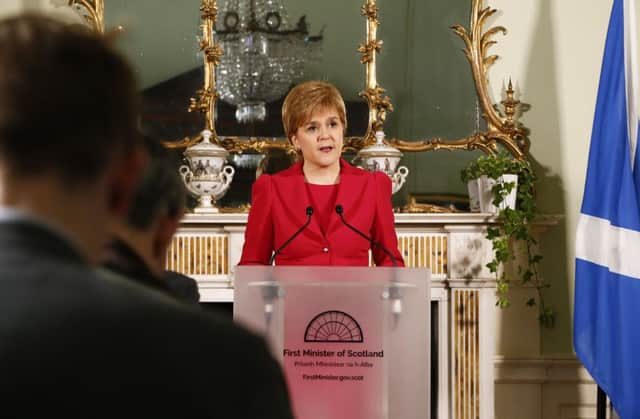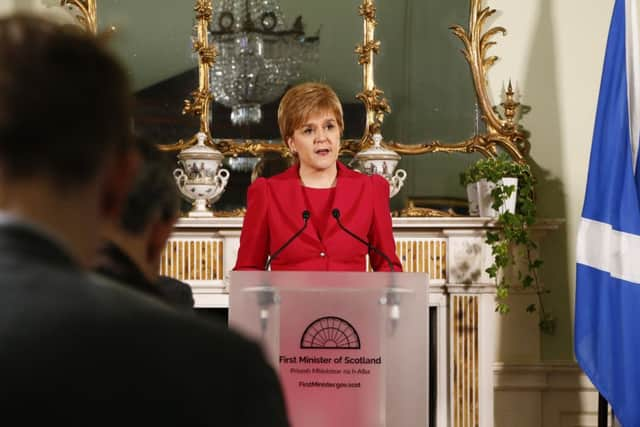Analysis: Nicola Sturgeon has backed herself into a corner


No-one had expected that the First Minister would announce her intention to request a section 30 order to transfer referendum holding powers from Westminster to Holyrood quite so soon.
Most had believed she would wait until this weekend’s SNP conference in Aberdeen to unveil her referendum plan in front of a sea of adoring activists.
Advertisement
Hide AdAdvertisement
Hide AdInstead, she caught everyone – including the UK government – on the hop with a bold press conference held when Westminster was consumed with the imminent triggering of Article 50 to leave the EU.


But once jaws had been picked up from the Bute House floor, there was a feeling that no matter how dramatic the timing of Ms Sturgeon’s announcement, there was a sense of inevitability about it.
In truth, yesterday’s big development had been on the cards ever since the UK voted to leave the EU and Ms Sturgeon said it was “highly likely” indyref2 was on its way.
Having fought the 2016 Scottish election on a manifesto which said another poll would be triggered if there was a “significant and material change in the circumstances” since the No vote two and a half years ago, Ms Sturgeon felt justified in breaking the SNP’s promise that the 2014 poll would be a once in a generation experience.
Having ramped up expectations of a second vote, Ms Sturgeon had backed herself into a corner and it would have been impossible for her to back down without a furious backlash from the independence supporters who have flocked to the SNP.


The difficulty for Ms Sturgeon is that her wish for a referendum at some point between autumn 2018 and spring 2019 is a gamble. The economic case for independence was Alex Salmond’s Achilles heel in 2014. The questions over what sort of currency an independent Scotland would use remain, while the financial situation is even more precarious given the catastrophic collapse of the oil price.
The most recent figures suggest Scotland is running a public spending deficit of almost £15 billion. The decisive nature of the 2014 No vote when 55 per cent of the Scottish electorate rejected independence, also means Ms Sturgeon has a mountain to climb.
In a Scotland that has grown increasingly polarised over the constitutional question, there will be many who resent yesterday’s announcement and view the prospect of more division with horror.
Advertisement
Hide AdAdvertisement
Hide AdKey to Ms Sturgeon’s strategy will be her claim that the UK government has failed to listen to the Scottish Government’s proposals for a Scottish specific Brexit deal that respected Scotland’s 62 per cent vote to Remain and protected its relationship with the single market.
Yesterday the First Minister fed that narrative by saying she had been met with a “brick wall of intransigence” from the UK government when faced with her proposals. A further complication for Ms Sturgeon is the uncertainty surrounding an independent Scotland’s place in the EU is an uncomfortable fit with her pro-EU rationale for holding a second vote.
There are, however, significant factors that offer the First Minister hope.
Yes campaigners are enthused and ready for round two – a state of affairs that contrasts with the remnants of the No campaign. The uneasy partnership between the Tories and Labour to create Better Together will not be repeated. The pro-Union side has no obvious figurehead and the collapse of Labour has seen its supporters drift to the SNP. The polls may suggest most Scots don’t want another referendum, but Ms Sturgeon will be encouraged by recent findings on the question of independence. The two most recent surveys suggest Brexit may have turned voters to independence with Yes support standing at 50 per cent and 48 per cent.
The Prime Minister now has the intensely demanding task of coping with a resurgent Scottish independence movement while grappling with the complexities of Brexit.
Mrs May, however, still has a strong card up her sleeve. It is Westminster that will decide whether to grant the 30 section order. A flat refusal is highly unlikely. But with Ms Sturgeon seeking a vote before Britain exits the EU, the likelihood is that Mrs May will try to delay the vote until after a deal has been struck. Let battle commence.